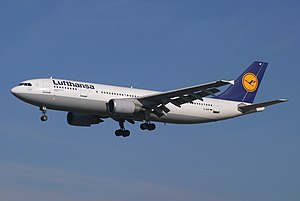Airplanes24.net
The Aviation Portal
Airbus A300: The Pioneering Aircraft That Transformed Modern Aviation
The Airbus A300, a groundbreaking aircraft that revolutionized the aviation industry, holds a significant place in the history of commercial flight. In this article, we will delve into the history, features, and impact of this remarkable plane.
The Genesis of Airbus A300
During the 1960s, European aviation manufacturers recognized the need for a wide-body aircraft to compete with American counterparts, such as the Boeing 747. This led to the birth of the Airbus Consortium, a collaborative effort between France, Germany, and the United Kingdom.
Designed to accommodate up to 300 passengers, the Airbus A300 became the first aircraft built by Airbus Industrie, the precursor to Airbus SE. Its maiden flight took place on October 28, 1972, marking a milestone for European aviation and ushering in a new era of air travel.
Breakthrough Features and Technological Advancements
The Airbus A300 introduced several groundbreaking features that set it apart from its predecessors:
1. Twin-Aisle Configuration
Embracing a twin-aisle layout, the A300 provided enhanced passenger comfort and convenience. With two aisles, the aircraft offered smoother boarding and disembarking processes, reducing congestion and improving overall efficiency.
2. Advanced Aerodynamics
Equipped with state-of-the-art wing design and wingtip fences, the A300 minimized aerodynamic drag, enhancing fuel efficiency and reducing operating costs. Its innovative design also contributed to reduced noise levels, providing a more comfortable flying experience for passengers.
3. Range and Versatility
With an impressive range of up to 4,070 nautical miles (7,540 kilometers), the A300 opened up new possibilities for long-haul flights. Its versatility allowed airlines to operate the aircraft on both short-haul and medium-haul routes, making it a popular choice for various airlines worldwide.
The Impact of the Airbus A300
The Airbus A300 had a profound impact on the aviation industry:
1. Economic Benefits
By providing a viable alternative to American aircraft manufacturers, the A300 stimulated competition, resulting in more affordable air travel. Its fuel-efficient design and ability to carry a large number of passengers significantly reduced operating costs for airlines, thereby making air travel more accessible to the masses.
2. Technological Advancements
The A300's technological innovations served as a blueprint for subsequent Airbus models. Its success paved the way for the development of the highly successful A320 family, A330, and A340, among others. Many of the A300's features, including the twin-aisle layout, were incorporated into these newer aircraft, further improving passenger experience and fuel efficiency.
3. Global Reach
The A300 played a crucial role in establishing Airbus as a major player in the global aviation market. It gained popularity among airlines worldwide, becoming a symbol of European engineering prowess and excellence. The success of the A300 propelled Airbus to become one of the leading aircraft manufacturers globally.
In Conclusion
The Airbus A300's introduction marked a turning point in the history of commercial aviation. Its innovative features, technological advancements, and economic benefits revolutionized the industry. The A300 not only laid the foundation for future Airbus models but also reshaped air travel, making it more accessible, efficient, and enjoyable for millions of passengers worldwide.

| A300B4-200 | A300-600R | A300-600F | |
|---|---|---|---|
| Cockpit crew | Three | Two | |
| Main deck | 281/309Y @ 34/31 in) max 345 |
247 (46F + 201Y)/285Y @ 34 in max 345 (3-3-3 Y) |
540 m3, 43 AYY ULD 9 AMJ/LD7 + 16 AYY |
| Lower deck | 20 LD3 + bulk | 22 LD3 + bulk / 158 m³ | |
| Length | 53.61 m (175.9 ft) | 54.08 m (177.4 ft) | |
| Height | 16.72 m (54.9 ft) | 16.66 m (54.7 ft) | |
| Wing | 44.84 m (147.1 ft) span, 260 m2 (2,800 sq ft) area 7.7 aspect ratio | ||
| Width | 5.287 m (17.35 ft) cabin, 5.64 m (18.5 ft) Fuselage, usually 2-4-2Y | ||
| Pressurized volume | 542 m3 (19,140 cu ft) | 860 m3 (30,370 cu ft) | |
| MTOW | 165,000 kg (363,763 lb) | 171,700 kg (378,534 lb) | 170,500 kg (375,888 lb) |
| Max payload | 37,495 kg (82,662 lb) | 41,374 kg (91,214 lb) | 48,293 kg (106,468 lb) |
| Fuel capacity | 48,470 kg (106,858 lb) | 53,505 kg (117,958 lb) | |
| OEW | 88,505 kg (195,120 lb) | 88,626 kg (195,387 lb) | 81,707 kg (180,133 lb) |
| Engines | GE CF6-50C2 or PW JT9D-59A |
GE CF6-80C2 or PW4158 |
|
| Takeoff thrust | 230 kN (52,000 lbf) | 249–270 kN (56,000–61,000 lbf) | |
| Takeoff (MTOW, SL, ISA) | 2,300 m (7,500 ft) | 2,400 m (7,900 ft) | |
| Speed | Mach 0.78 (450 kn; 833 km/h; 518 mph) at 35,000 ft (11 km) MMO: Mach 0.82 |
||
| Range | 5,375 km (2,900 nmi; 3,340 mi) | 7,500 km (4,050 nmi; 4,700 mi) | |
